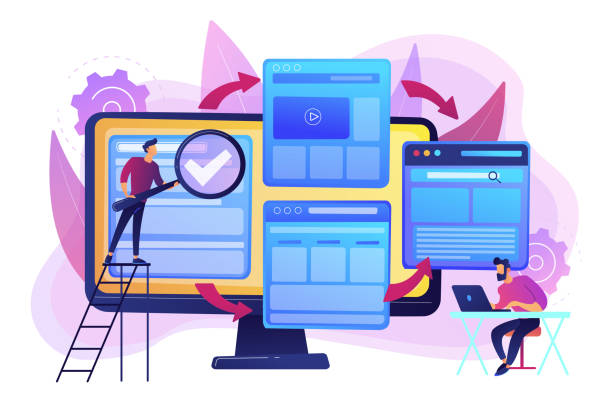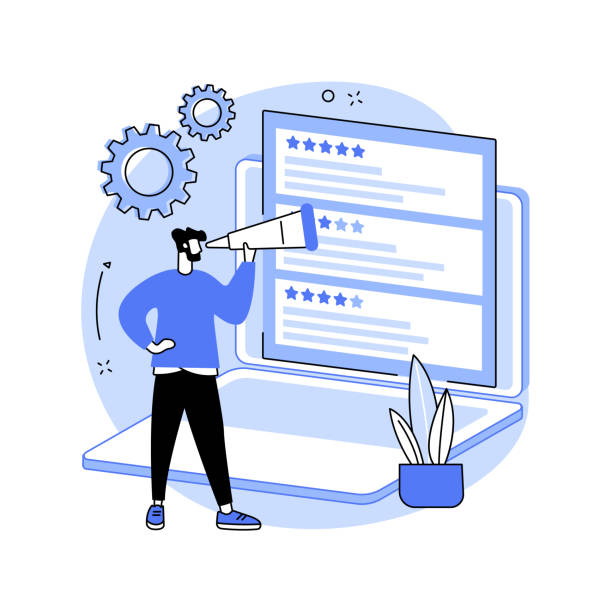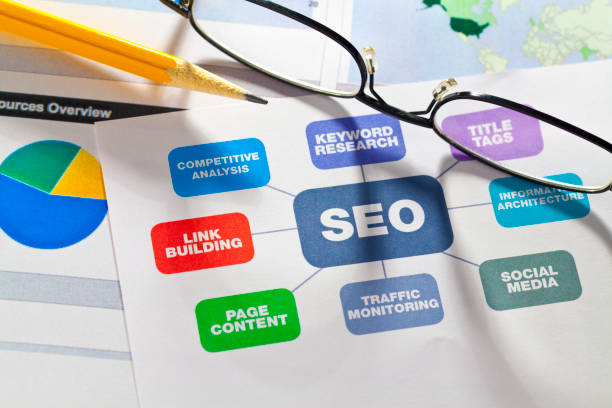The Importance of Site Speed in Today’s World and the Role of Fast Website Design

In the current digital age, where competition for user attention has peaked, website loading speed is not just an advantage, but a critical necessity.
Internet users have high expectations, and any delay in page loading can mean losing visitors and, ultimately, business opportunities.
The concept of #fast_website_design and #web_optimization has emerged for this very purpose.
Research shows that even a one-second delay in page loading can lead to a 7% reduction in conversion rates, an 11% decrease in page views, and a 16% drop in customer satisfaction.
These statistics clearly demonstrate the importance of investing in fast web development for any online business.
The goal of fast website design is to provide an exceptional user experience; an experience that not only doesn’t tire them but encourages them to browse your site with pleasure and without interruption.
This is especially critical for e-commerce websites, news portals, and any platform that requires continuous user interaction.
Did you know that Google also considers site speed as one of the key ranking factors? Yes, this means that a slow site, even with excellent content, may rank lower than its competitors in search results.
Therefore, #website_performance and #loading_speed are two main pillars for success in today’s SEO.
From the user’s perspective, a fast site means more satisfaction and a higher likelihood of return.
This positive cycle ultimately leads to increased traffic, improved branding, and business growth.
In this article, we will comprehensively cover various aspects of fast website design and provide practical solutions for achieving it.
Are you tired of losing business opportunities due to not having a professional corporate website?
Rasaweb helps you with professional corporate website design:
✅ Build a powerful and reliable image for your brand
✅ Convert site visitors into loyal customers
⚡ Get a free consultation now!
Key Factors Affecting Website Speed (Explanatory and Analytical)

To achieve fast website design, one must first understand the factors affecting speed.
These factors can be broadly divided into two categories: server-side factors and client-side (frontend) factors.
Among the most important server-side factors is hosting quality.
Choosing a suitable and high-speed hosting with sufficient resources (such as RAM and CPU) and using SSD servers is the first step in ensuring site speed.
CDN (Content Delivery Network) also plays a significant role in content distribution and reducing loading time for users in different geographical locations.
By using CDN, your site’s static content is delivered from the closest server to the user, which significantly reduces latency.
In addition, database optimization, using new PHP versions, and correct web server configuration (such as Nginx or Apache) are also highly important.
On the other hand, client-side factors include image size, use of unoptimized scripts and styles, and lack of file compression.
Large images with inappropriate formats can severely slow down loading speed.
Compressing images without significant quality loss and using next-generation formats like WebP are effective solutions in this regard.
Also, Gzip or Brotli compression for CSS, JavaScript, and HTML files can significantly reduce the size of transmitted files.
Minimizing HTTP requests, combining CSS and JS files, and lazy loading images and videos are also more advanced techniques in web optimization.
Accurate identification of these factors and applying necessary optimizations in each section is the key to achieving a fast and efficient website design that not only keeps users satisfied but also significantly helps improve the site’s ranking in search engines.
Continuous analysis of site speed with tools like Google PageSpeed Insights and GTmetrix is also essential for identifying and resolving speed bottlenecks.
Optimizing Images and Media for Speed Increase (Specialized and Guidance)

One of the biggest obstacles to fast website design is the large size of images and other media.
Images often constitute a significant portion of the total web page size, and optimizing them can have a dramatic impact on loading speed.
The first step in this process is choosing the appropriate image format.
For high-detail photos, JPEG is more suitable, and for graphics with transparency and limited colors, PNG is better.
However, next-generation formats like WebP, developed by Google, offer much better compression while maintaining similar quality.
Using these formats can reduce image sizes by 30-50%.
The next step is image compression.
Numerous online and offline tools are available that can compress your images without noticeable quality loss.
Even content management systems like WordPress have plugins for automatic image compression upon upload.
Image Compression Tools:
| Tool Name | Type | Advantages | Suitable For |
|---|---|---|---|
| TinyPNG/TinyJPG | Online | High-quality compression, free | Web images, quick optimization |
| ImageOptim | Desktop (macOS) | Lossless quality, supports various formats | Developers, batch compression |
| ShortPixel | WordPress Plugin/API | Automatic compression, WebP conversion | WordPress sites |
In addition to compression, using Lazy Loading for images and videos is very important.
This technique ensures that images are loaded only when they enter the user’s viewport, not at the initial page load.
This significantly increases the initial loading speed, especially for pages with a lot of content and numerous images.
Specifying image dimensions (width and height) in the HTML code also helps the browser reserve the necessary space for the image without fully loading it, preventing Layout Shift, which in turn helps improve Core Web Vitals and user experience.
Finally, continuous media optimization is an integral part of the fast website design process and should be reviewed periodically.
The Role of Optimized Coding and File Compression in Site Speed (Educational)

The quality of coding and file optimization are two fundamental pillars in achieving fast website design.
Clean, efficient, and error-free coding is the foundation of a high-speed website.
This includes optimizing HTML, CSS, and JavaScript codes.
For HTML, ensuring correct semantic structure, reducing DOM tree complexity, and avoiding superfluous tags can help speed up page rendering.
Regarding CSS, using Minification (removing extra characters like spaces and new lines) and Compression (compressing files with algorithms like Gzip or Brotli) is crucial for reducing the size of style files.
Also, combining smaller CSS files into a larger one (Concatenation) can reduce the number of HTTP requests, which in turn increases loading speed.
However, the main challenge often lies in JavaScript.
Heavy and unoptimized scripts can severely slow down a site because the browser has to wait for these scripts to download, parse, and execute before it can finish rendering the page.
To combat this problem, techniques such as Deferring (delayed loading) and Async Loading (asynchronous loading) scripts are used.
Using the defer and async attributes in the <script> tag allows the browser to continue loading and rendering HTML while scripts are downloaded in the background.
This is particularly important for fast website design and improving Core Web Vitals like FID (First Input Delay).
Furthermore, eliminating unnecessary code (Dead Code Elimination) and optimizing library dependencies also play a significant role in reducing the size of JS files.
Modern JavaScript frameworks like React, Angular, and Vue also offer tools for optimization and Code Splitting, which helps load only the necessary parts of the code when needed.
By observing these points in coding and compression, website speed can be significantly increased, providing a smoother experience for users.
This specialized and technical approach to optimization is an inseparable part of the process of building a high-speed website.
Are you frustrated with the low conversion rates of your online store?
Rasaweb is your definitive solution with professional e-commerce website design!
✅ Increase your sales and revenue
✅ Provide an exceptional user experience for your customers
⚡ Get a free consultation now!
The Importance of Caching and CDN in Site Performance (Explanatory and Specialized)

Two fundamental concepts in fast website design that are often overlooked are Caching and Content Delivery Networks (CDN).
Caching means temporarily storing information closer to the user so that in subsequent visits, there is no need to reload from the main server.
This significantly reduces loading time and also lessens the load on the server.
Caching can be done at various levels:
- Browser Caching: The user’s browser stores static files (such as images, CSS, JS) so that they don’t need to be re-downloaded on subsequent visits to the same site.
This is done by correctly setting HTTP headers likeCache-Control. - Server Caching: The server stores pages or database query results.
This is especially crucial for dynamic sites with a lot of content, like WordPress.
Caching plugins like WP Rocket or LiteSpeed Cache for WordPress are examples of this type of caching. - Object Caching: For more complex applications, caching database query results or the output of computational operations can significantly improve performance.
Redis and Memcached are popular tools for Object Caching.
But what is CDN and how does it help fast web development? CDN, or Content Delivery Network, is a network of servers distributed in different geographical locations around the world.
When a user visits your site, static content (images, CSS, JS) is served from the CDN server closest to them, rather than from your main site server.
This significantly reduces latency and improves user experience, especially for international users.
In addition to increasing speed, CDN also offers security benefits and can be effective in protecting the site against DDoS attacks.
The intelligent combination of caching and CDN allows you to have a fast and stable website design that maintains its performance even at a large scale.
The Effect of Site Speed on SEO and User Experience (Analytical and Provocative)

Did you know that website speed not only affects the direct user experience but is also considered one of the most important ranking factors in Google? It’s an undeniable fact that search engines are increasingly focusing on site speed as a ranking signal.
By introducing Core Web Vitals metrics (including Largest Contentful Paint – LCP, First Input Delay – FID, and Cumulative Layout Shift – CLS), Google has clearly shown that user experience is at the core of its algorithms, and speed is an integral part of this experience.
A fast website design directly leads to a reduced Bounce Rate; meaning fewer users leave your site before the page fully loads.
Also, users spend more time on your site and visit more pages, which sends positive signals to search engines.
From a business perspective, site speed directly impacts the Conversion Rate.
A slow site can mean losing sales, registrations, and other business goals.
Suppose a user intends to buy a product; if your website is slow, they will easily go to a competitor’s site.
This is where the question arises: Are you willing to risk losing potential customers because of a slow site?
The impact of site speed on user experience goes beyond just loading time.
Fast websites convey a sense of professionalism and trust.
Users perceive them as more reliable and credible.
Conversely, a slow site can lead to dissatisfaction, frustration, and ultimately, damage to brand reputation.
In a competitive world where hundreds of options exist for every online need, fast website design can be your differentiating factor from competitors.
Therefore, speed optimization is not just a technical measure, but a strategic investment for the future of your online business.
Tools and Methods for Website Speed Testing (Guidance and Specialized)

To ensure that your efforts towards fast website design have been fruitful, you need accurate and reliable tools for testing and monitoring site speed.
These tools help you identify speed bottlenecks and address weaknesses.
Some of the most widely used and effective tools include:
- Google PageSpeed Insights: This free Google tool gives your site a score from 0 to 100 for both mobile and desktop and provides suggestions for speed improvement.
These suggestions include image optimization, caching, removing render-blocking resources, and more. - GTmetrix: Another powerful tool that provides comprehensive reports on site speed, full load time, number of requests, and page size.
GTmetrix uses PageSpeed and YSlow metrics and provides a list of optimization recommendations with full details. - WebPageTest: This tool allows testing site speed from different geographical locations and with various browsers.
Its reports are very precise and technical, including a Waterfall Chart that shows the order of resource loading and helps identify slow resources. - Chrome Lighthouse: An open-source auditing tool directly integrated into the Chrome browser.
Lighthouse not only checks speed and performance but also evaluates SEO optimizations, accessibility, and development best practices.
Comparison Table of Site Speed Testing Tools:
| Tool Name | Capabilities | Main Advantage | Suitable For |
|---|---|---|---|
| Google PageSpeed Insights | Scoring, Google suggestions, Core Web Vitals | Focus on Google metrics | All users, especially for SEO |
| GTmetrix | Comprehensive reports, Waterfall Chart, Performance history | Deep analysis | Developers and SEO specialists |
| WebPageTest | Testing from different global locations, mobile simulation | Detailed network and rendering analysis | Advanced developers |
The important point is that speed testing should be done continuously, especially after any major changes to the site.
This analytical and continuous approach guarantees success in maintaining a fast and optimized site.
The Relationship between Responsive Design and Site Speed (News and Explanatory)

In today’s world, where a large portion of internet traffic comes from mobile devices, responsive design has become an indispensable standard.
But did you know that responsive design is not just about correctly displaying the site on different screen sizes, but also has a close connection with site loading speed and performance? The good news is that a good responsive design can contribute to fast website design, and the not-so-good news is that a poor responsive design can do exactly the opposite.
True responsive design should be such that it does not load unnecessary content for smaller devices (like mobile).
For example, large images optimized for desktop display should not be loaded unchanged on mobile devices.
Using responsive images with the srcset and sizes attributes in HTML allows the browser to select and load the most appropriate image version based on the user’s screen size.
This significantly reduces the volume of transferred data and helps with loading speed.
In addition to images, loading CSS and JavaScript codes specific to certain devices should also be optimized.
Use Media Queries intelligently so that only the necessary styles for each device are loaded.
Avoiding heavy web fonts or complex JavaScript scripts in mobile versions of the site can make a significant difference in performance.
Google has explicitly stated that it has adopted ‘Mobile-first indexing,’ meaning your site’s mobile version is indexed and ranked first.
Therefore, mobile speed is more crucial for SEO than ever.
A responsive site that performs slowly on mobile, even if it’s fast on desktop, will still not get a good ranking in mobile search.
Thus, in the process of fast website design, special attention must be paid to both responsiveness and performance across various devices simultaneously.
Tired of losing customers due to poor e-commerce website design? With Rasaweb, solve this problem forever!
✅ Increase sales and convert visitors into customers
✅ Smooth and engaging user experience for your customers⚡ Get a free consultation
Server-Side and Database Optimization (Specialized)

Fast website design is not limited to client-side optimization alone; server and database performance also play a vital role in overall website speed.
A slow server or an unoptimized database can render even the most optimized front-end codes ineffective.
Choosing Suitable Hosting: As mentioned earlier, selecting quality hosting that matches your site’s needs is very important.
Shared hosting might be cheaper, but their limited and shared resources can severely reduce site speed.
In contrast, Virtual Private Servers (VPS), Dedicated Servers, or Cloud Hosting provide greater flexibility and power for resource management and server optimization.
Database Optimization: The database is the backbone of any dynamic website.
Inefficient database queries can significantly increase server response time.
Database optimization solutions include:
- Indexing: Ensuring that all columns used in queries are properly indexed significantly increases data retrieval speed.
- Database Cleanup: Deleting old information, superfluous records, and temporary data can reduce database size and speed up queries.
- Using Database Caching: Storing frequently queried results in a cache (like Redis or Memcached) can eliminate the need to re-execute queries and reduce server load.
- Query Optimization: Rewriting complex or inefficient queries in a more optimized way can make a big difference in performance.
UsingEXPLAINin MySQL is useful for analyzing query performance.
Web Server Configuration: Using new PHP versions (such as PHP 8.x, which has significant performance improvements), enabling Gzip or Brotli compression on the server, and correctly configuring web servers like Nginx or Apache all contribute to improving server response speed.
Server-side optimization is a complex and technical process essential for achieving maximum speed in building a high-speed website.
Preventing Common Site Speed Issues (Guidance and Educational)

Even with the best intentions in fast website design, you may encounter common challenges and issues that affect your site’s speed.
Understanding these problems and how to prevent them is a crucial step in maintaining optimal site performance.
One of the most common problems is excessive use of plugins and third-party scripts.
Every plugin or script added to your site consumes resources and can create new HTTP requests, which adds to loading time.
The solution is to use only essential and high-quality plugins and regularly remove or deactivate unnecessary ones.
Always check the performance impact of a new plugin before installing it.
Another issue is lack of web font optimization.
Custom web fonts can enhance the visual appeal of a site, but if not optimized correctly, they can severely reduce speed.
Use fewer fonts, load only the necessary weights, and use formats like WOFF2, which offer better compression.
Also, you can use the font-display: swap; property in CSS to display text even before the font fully loads.
Redirect Chains can also slow down a site.
Each redirect creates an additional HTTP request, and the browser has to wait to reach the final destination.
By reviewing and correcting redirects to point directly to the final destination, you can resolve this issue.
Finally, lack of regular updates for Content Management Systems (CMS), plugins, and themes can also lead to speed reductions and security issues.
Regular updates often include performance improvements and bug fixes that help maintain site speed and security.
This is practical guidance for developers and site managers to be aware of these challenges, always have a fast and efficient site, and benefit from the advantages of fast website design.
Frequently Asked Questions
| Question | Answer |
|---|---|
| What is fast website design? | It refers to the process of building a website that is developed and launched in a short time, usually by using ready-made platforms or optimized methods. |
| Why is speed important in website design? | High speed improves user experience, increases SEO ranking, and boosts the conversion rate of visitors into customers. |
| What tools are available for fast website design? | Content Management Systems (CMS) like WordPress, Joomla, and Drupal, drag-and-drop website builders, and fast web development frameworks. |
| What are the advantages of using CMS for fast design? | Ready-made templates, various plugins, easy content management without much coding, and a large user community for support. |
| Does fast website design mean low quality? | Not necessarily. By using appropriate tools and methods, a high-quality website can also be designed quickly. |
| What factors affect website design speed? | Project complexity, designer’s experience, choice of platform or appropriate tools, readiness of content and images, and effective communication with the client. |
| How is responsive design considered in fast website design? | Most templates and fast design tools are responsive by default and require minimal or no settings. |
| What is the cost of fast website design? | The cost varies depending on complexity, chosen platform, and additional services, but it is usually less than custom design from scratch. |
| How can the loading speed of a designed website be increased? | Image optimization, browser caching, file compression, use of CDN, and choosing suitable hosting. |
| When is fast website design a suitable option? | For small businesses, startups, personal websites, or projects that need a quick launch and have a limited budget. |
And other services of Rasaweb Advertising Agency in the field of advertising
Smart Conversion Rate Optimization: An effective tool for online growth with the help of custom programming.
Smart Advertorials: A professional solution for increasing sales with a focus on precise audience targeting.
Smart Sales Automation: A dedicated service for growth in SEO ranking improvement based on precise audience targeting.
Smart Marketing Automation: A fast and efficient solution for improving SEO ranking with a focus on SEO-driven content strategy.
Smart Conversion Rate Optimization: An effective tool for improving SEO ranking with the help of key page optimization.
And over a hundred other services in the field of internet advertising, advertising consultation, and organizational solutions
Internet Advertising | Advertising Strategy | Advertorials
Resources
Website Optimization Tips
Fast Website Design
SEO and Web Design
Effective Website Design
? Rasaweb Afarin Digital Marketing Agency, your strategic partner on the path to online growth and prominence. We guide your business towards the peaks of success by providing innovative solutions, from secure website design to professional SEO optimization.
📍 Tehran, Mirdamad Street, next to Bank Markazi, Kazeroon Jonubi Alley, Ramin Alley, No. 6




